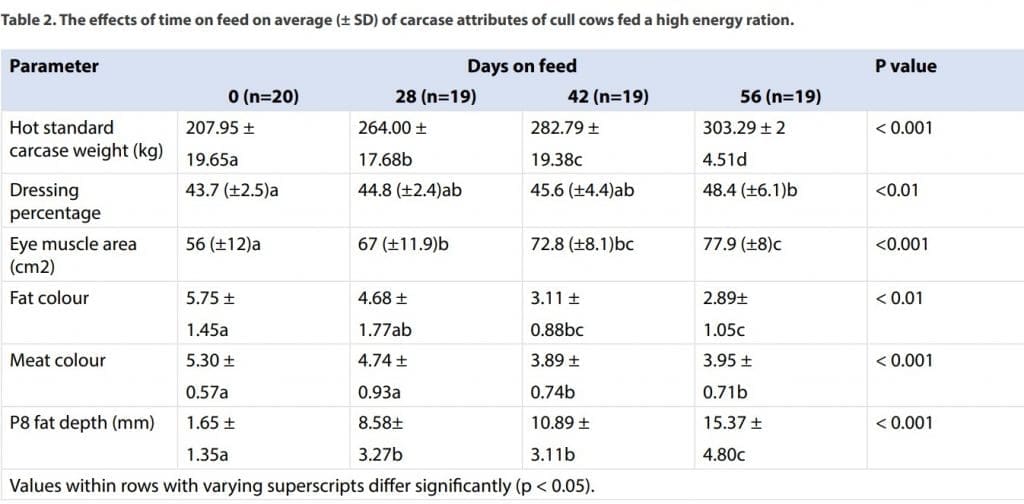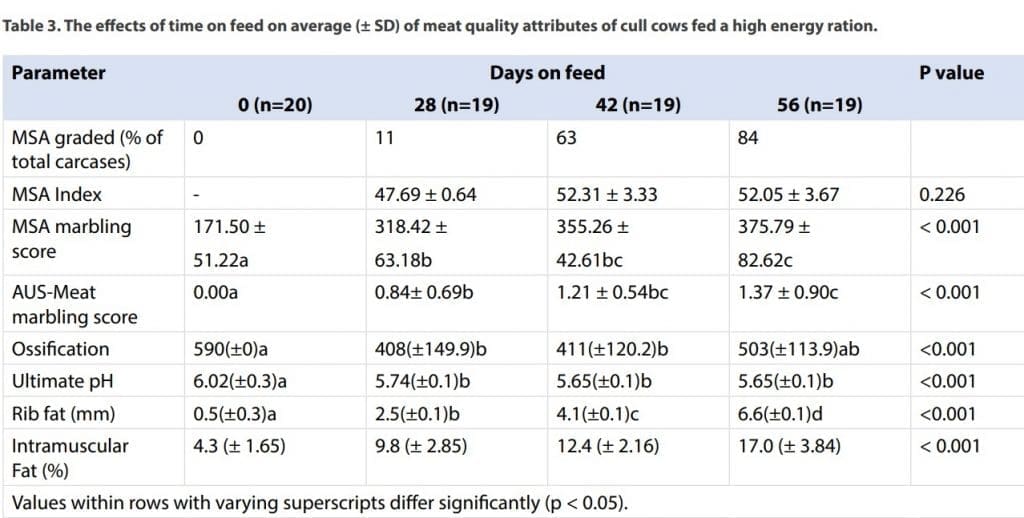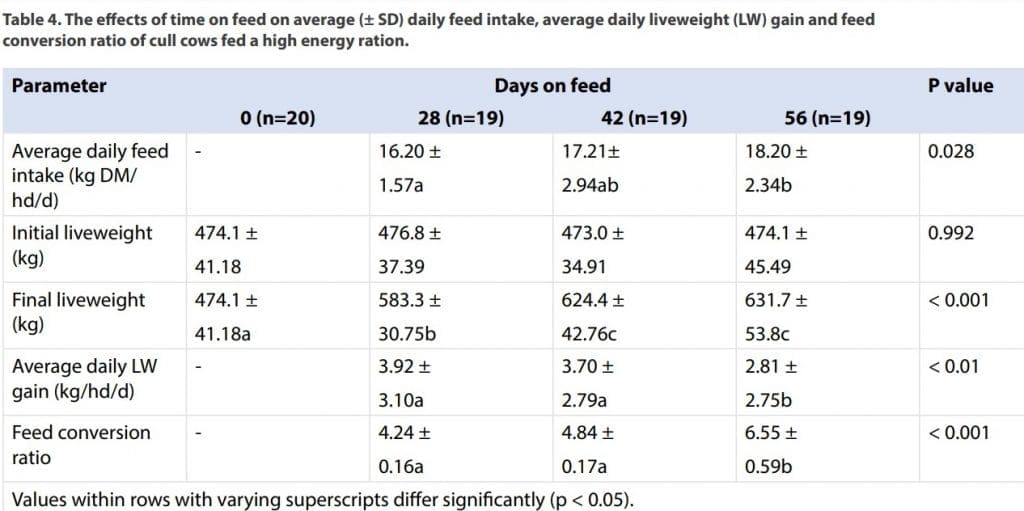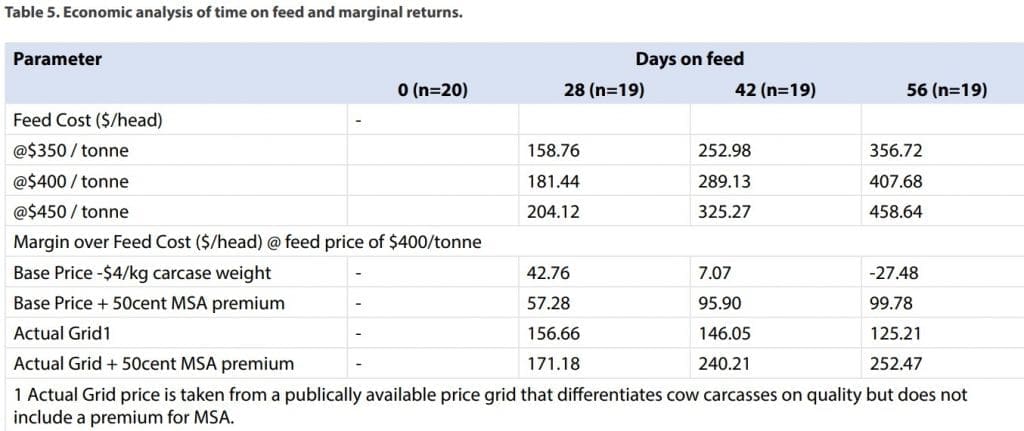SIGNIFICANT potential exists to increase the quality grade of carcases from aged cows by putting them on feed programs for a period before slaughter, recent research has shown.
However profitability in the exercise is likely to be determined by feed price and the ability of the market to pay a premium for the higher quality beef.
Presenting during a webinar hosted by the Graham Centre for Agricultural Innovation on Friday, Charles Sturt University’s Dr Michael Campbell outlined results from a project looking into the effects on live animal performance and meat quality through strategic feeding of a high energy ration to cull cows.
Dr Campbell made the point that with the current reduction in national beef herd numbers and lower rates of slaughter, industry needs to extract as much value from every carcase processed as possible, including older females.
“There has been a shift in the beef industry to producing more branded, premium quality products, which can extract further value from animals that have high eating quality attributes,” he said.
“With this in mind, it’s important that producers understand how cows that have been culled from a breeding herd may be managed to result in better meat quality outcomes.”
Conditioning cows through feeding of an energy-dense ration prior to slaughter has already been shown in earlier studies to significantly increase liveweight and thus improve not only carcase composition, but also meat quality characteristics. But many of the earlier studies were conducted using growth promotants to increase the lean component of the cow carcases, designed to target the grinding beef market. Much less work has been done on improving carcase quality.
Under the industry’s new Eating Quality Grade (EQG) cipher which shifts the emphasis away from using traditional carcase descriptors such as dentition and meat colour, to purely focusing on eating quality, a potential avenue now existed for primals from aged cull cows to be sold under the EQG cipher, allowing producers to extract more value from the carcase.
“There have been plenty of old cows being fed in feedlots (for weightgain reasons) this past year – and there have been for a few years, but what does it mean for quality?” Dr Campbell said during Friday’s webinar.
“Can we extract more value out of these culls cows, getting a better quality product, even if it is just for a few of the primal cuts, like cube rolls and striploins?” he asked.
For the research project, a mob of 77 Angus and Angus cross cull cows aged 6-7 years, in poor body condition (BCS of 1.5-2) were sourced from a commercial beef property near Colac, NSW. The cows were being culled due to age and the on-going drought conditions, and were preg-tested empty.
They were randomly allocated to one of four experimental groups – 0, 28, 42 and 56 days-on-feed (DOF).
The control group (0 days on feed) was sent straight to slaughter at the Teys Wagga plant. The remaining three groups, totalling 57 head, were randomly allocated to the 28, 42 and 56 day (four, six and eight week) feeding groups, and fed at the Charles Sturt cattle feeding pens.
All groups were provided with the same basic pellet/hay/straw/canola meal ration, formulated to contain 15pc crude protein, 40pc neutral detergent fibre and a minimum of 10.5 megajoules of energy, DM basis.
The ration was designed to reflect what any cattle producer could achieve without expensive milling, mixing or feeding equipment, in a small paddock, Dr Campbell said.
Cattle were followed through to slaughter where a full MSA grading applied. Meat samples were taken at the time, intended for MSA consumer testing, but COVID restrictions have delayed that part of the research project to this point (see more references below).
Results
As was expected, liveweight, carcase weight and quality increased with increased time on feed (see table below). The number of carcases that met the required standards to be given an MSA index increased to 84pc after 56 days on feed, compared with only 11pc after 28 days on feed.
Carcase weights lifted from an average 208kg in the control group (droughted cull cows), to 264kg in the 28-day fed group, 283kg in the 42-day fed group and 303kg in the 56-day fed group.
Fat depth, fat colour and meat colour all improved, as did carcase yield, from 0 DOF to 42 DOF.

Substantial increases in weightgain were also seen. The first week’s result was basically gut-fill, while over the first four weeks liveweight gain averaged around 4kg/day. After six weeks on feed, however, rates of liveweight gain slowed down. The weightgain over the final couple of weeks, from 42 out to 56 days, lifted from only 624kg to 632kg.
“That’s kind of what we expected,” Dr Campbell said. “They are going to slow down, as they hit their mature weight. The secret is in picking that sweet-spot where we get optimum weightgain, but also producing a quality product out the other end,” he said.
However, weightgain was fundamentally a ‘given’ in the experiment – the project’s focus was more on what quality improvement could be extracted.
An interesting feature was intramuscular fat improvement. Cows on feed out to 56 days produced an average IMF of 17pc, compared with 12pc after 42 days on feed. AusMeat marbling scores in the 56-day fed group did not show a significant difference, however, between six and eight weeks on feed (1.37 average BMS vs 1.21 BMS).
“But what we are interested in is whether taste panel testing shows whether consumers can pick up that higher IMF percentage in these longer-fed carcases.
“If we just went solely off the AusMeat MSA marbling score results, we did not see a significant difference,” Dr Campbell said. “But what we did see was an increase in the overall number of carcases that graded.
“When we start thinking about this from a risk management point of view, if we are going to feed cows, and want to grade MSA for a particular market, then feeding them for 56 days (eight weeks) gives a lot better risk-management – 84pc of them graded MSA, with only one or two carcases that did not grade.”
“Looking at the experiment from a risk management viewpoint, six weeks on feed gives the best efficiency in terms of liveweight gain, but eight weeks manages our quality issues better.”
Economics
Dr Campbell said some attention had been applied to developing an economic model to help guide cow-feeding programs.
“Everyone is going to have different labour costs and feed costs. But to keep this simple, we focussed only on margin over feed cost. If there was a profit above that, users could work out whether it covered their labour, repairs and maintenance, fuel and other costs,” he said.
While the modelling sounded simple to start with, it became more complicated when looking at price grids for cows offered by some processors.
If a base price of say, 400c/kg carcase weight is applied (relevant at the time of the study, but cows are worth a lot more than that now), the margin over feed cost decreased after four weeks on feed. Big increases in weightgain during the first four-week period become less efficient as the cows were fed on.
Beyond the weightgain component, if a 50c/kg premium was applied to all carcases grading MSA (which was a figure seen in NSW MSA markets at the time), the impact of the quality grade on the margin over feed cost increased, through to the eight-week feeding period, when the margin rose to almost $100/head, compared with $57 at the 28-day feeding period.
“That’s just solely because more carcases were grading MSA,” Dr Campbell said.
The trial showed that the big financial gains in feeding cows came not in the first four weeks when ADG was optimised, but during the final four weeks when MSA premiums based on meat quality improvement started to take effect.
“It’s all round the quality product, as more cattle grade MSA,” he said.
Dr Campbell flagged the presence of some early successful branded beef programs based on better quality cull cows, such as HW Greenham’s Vintage Beef program, profiled in this earlier Beef Central report.



